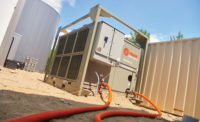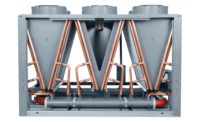Not all of the commercial HVAC market is thriving these days, as the pandemic lingers. But several segments are seeing strength due to continuing trends. Chillers play an integral part in the HVAC systems for these markets.
Demand for chillers is up over 30% in 2021 compared to 2020, said Tom Franaszek, director of product management at Carrier Commercial HVAC Global Management. Air-cooled chillers are growing the fastest. With continued economic growth, Carrier believes demand for all types of new chiller equipment will grow heading into 2022, Franaszek said.
One of the biggest areas of growth is data centers. As the entire world seemed to go online last year, from work to school to shopping, data centers saw increased activity. That increased activity means more heat, and that means an increased demand for cooling. The operators of these facilities are also showing more interest in IAQ and efficient performance throughout the day, said Todd Grabowski, vice president of chillers and air handlers at Johnson Controls.
“Data centers are certainly an area that we are seeing a tremendous amount of growth and opportunity,” Grabowski said.
Specialized Cooling Applications
Data centers demand specialized cooling applications that are different from other chiller applications, Grabowski said, because they need more sophisticated controls. The industry is also pushing to improve efficiency and decrease operating costs, reduce lifecycle costs, and decrease the carbon footprint, all while offering low-GWP refrigerant options to comply with future regulations. Johnson Controls is also seeing customers in Europe and Asia demand more heating applications through chiller equipment.
Data centers are particularly concerned with pairing reliability and energy savings due to the combination of high capacity and run hours, Franaszek said. Many data centers use air-cooled chillers and include free cooling as a strategy. To meet this need, Carrier developed a system that optimizes both the mechanical and free cooling parts of the system.
Besides data centers, Johnson Controls has seen steady growth in health care, education, entertainment venues, and transportation industries, Grabowski said. Much of this growth can be attributed to a backlog that has built up between construction being halted and a shortage of labor and materials, all of which have contributed to the demand, he said. Franaszek said K-12 schools provide another growth opportunity due to an increase in federal funding for upgrades.
Schools Focus On Healthier Environments
“K-12 schools are investing in the health of their students and faculty with requirements for advanced chillers, air handling units, and controls using a combination of rooftop units and chillers to create state-of-the-art HVAC systems,” he said. “The focus is on healthier indoor environments while ensuring energy savings.”
Moving forward, Johnson Controls is offering its clients cloud-based solutions for their chiller needs. For example, its Smart Connected Chillers solution alerts a facility manager or building owner of when a chiller goes down, runs at less than peak efficiency, or needs preventive maintenance to avoid unexpected, more expensive repairs in the future. These services are all available with remote monitoring and diagnostic support.
“We continue to advance our chiller technologies to meet our customer’s demands while supporting their sustainability goals as well as decreasing energy usage, decreasing emissions, and keeping operating costs in line with expectations,” Grabowski said.
Carrier will be launching a new water-cooled centrifugal chiller soon. It is designed to deliver reliable performance, efficiency, easy installation, and a wide operating range. With capacity from 350 to 600 tons (1,231 kW – 2,110 kW), the chiller will combine efficiency for design and the ability to operate at severe conditions due to unexpected building operation or extreme weather. It will use Carrier’s two-stage back-to-back compressor technology to achieve performance while staying quiet and cool under pressure. The extended operating range will provide reliability with improvement in chiller energy efficiency and building resiliency for specifying engineers, building owners, and facility managers, Franaszek said.
Refrigerants Meet Needs
The other major area of advancement for chillers is the transition to a lower-GWP refrigerant. Franaszek said Carrier is committed to delivering the right refrigerant for each application considering a combination of lower GWP, lower refrigerant charge, and higher energy efficiency to reduce the overall carbon footprint of its customers.
Johnson Controls has committed to R-454B as a future environmentally sustainable refrigerant solution in North America. Grabowski said it will serve as the primary low-GWP refrigerant in the company’s ducted residential and commercial unitary products as well as air-cooled scroll chillers. Many factors are impacting this transition, he said, including access to raw materials and the ongoing labor shortage.






Report Abusive Comment